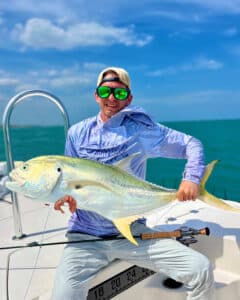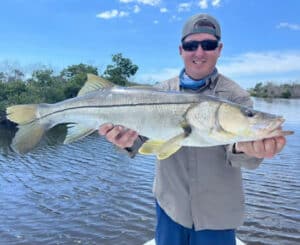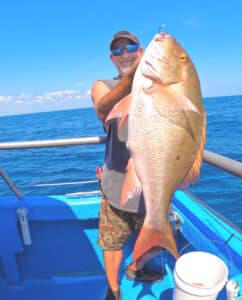From the land to the deep sea, Stuart’s inshore and offshore waters offer an abundance and variety of different catches. We’re proud to team with the Coastal Angler to bring you the latest fishing reports to help put you on the fish and keep your lines tight



Few things bring me as much excitement and joy in the morning as running the boat through the inlet and starting on a journey to explore the beaches. Each outing holds the promise of discovery, and even if the initial search yields nothing, there’s always the option to venture a bit further offshore.
Fly fishing by sight is the name of the game, and I can’t think of a single serious angler who doesn’t feel a surge of adrenaline at the sight of a school of tarpon, snook gracefully gliding along the shoreline, or the appearance of tarpon, jacks, albies, or mackerel.
To ensure swift action and immediate casting, I always have an 8, 10, and 12 weight rod at the ready in the boat. Each rod is equipped with a floating, intermediate, or fast sinking line, offering nine combinations ready to deploy at a moment’s notice. Efficiency is key when it comes to presenting the fly quickly to the fish, as seizing the moment can often be the difference between success and failure.
When it comes to casting, a few key techniques can greatly improve accuracy and distance. Avoiding dropping the tip on the back cast and mastering the double haul are essential. The double haul technique follows quick and efficient casting, the fly farther and faster. Maintaining line speed and achieving a clean turnover, particularly through the line hand, enhances overall efficiency.
As we embrace the summer season, it’s important to cherish our natural surroundings and the opportunities they provide. Despite the challenges posed by environmental issues such as toxic discharges, our coastal paradise remains a place of unparalleled beauty and a sanctuary for those who love and live life outdoors. So, let’s make the most of it and get out there to fish!
Beach
Summertime is all about snook and tarpon. If you’re new to fishing from the shore your set is same you can use in the river. I use a 7’6” medium heavy rod from Blackfin Rods. Penn Slammer with 30 lb. Super Braid from Yo-Zuri, and a 50 lb. leader with a Yo-Zuri Crystal Minnow. This set is all you need to catch big fish from the beach. Snook will be all over the place at first light and then again and dawn. Tarpon bite will be good at night and first light. Best beaches are those with structure–Walton Rocks, St. Lucia, and Hobe Sound at the north end. There is still plenty of big jack crevalle around. Throw a spoon or top water to get that exciting bust up top.
River
If you’re wade fishing, head north to around the power plant up to Fort Pierce. Stuart and Jensen don’t have sea grass, so focus on wading in Herman Bay area with a popping cork and shrimp. Cast net live mullet if you can get them. Trout, redfish and snook will be up against the mangroves so make sure you’re focusing on these areas. On the west side of the river, focus on the docks from Walton Road to Midway Road. Make sure you check the tides and don’t overlook top water lures for the snook and tarpon.
Bridge
Bridge fishing will be hot and can be enjoyed by the whole family. Snook fishing is best at night with live mullet or greenies. Tarpon will be around so use heavy equipment to get the fish in fast. The Jensen causeway catwalk on both sides is great. Also, the north side of the Stuart causeway is great with moving current. Fish the lights and use big mullet to get hooked up.
There are so many places on the Treasure Coast to explore without a boat. So, get out and enjoy the outdoors. Tight lines!
June is a great month for fishing here on the Treasure coast. Usually, early mornings and late afternoons are the most productive for inshore fishing. Snook fishing at first light with live bait and or artificial baits such as topwaters, subwalks, MirrOlures, and the like, is a blast this month when fishing along local beaches in the surf and near local inlets.
Remember to handle the larger breeding fish with care, get a quick picture, and put the fish back in the water gently and safely. Expect some larger tarpon, jacks, redfish, and permit in the mix near local inlets as well. Tarpon fishing near deeper channel edges inshore will produce bigger fish on either tide. Moving water is key, dead or live mullet will usually produce bites if you have the patience.
Nearshore fishing has been red hot for tarpon, jacks, kingfish, bonito, permit, and sharks. Early mornings can be very productive for sight fishing tarpon along local beaches. Find schools of rolling fish and cast crabs or whitebaits to the lead fish for steady hookups. Same technique will work great for large jack crevalle schools migrating down the beaches this time of year too. Live white baits or pretty much any large artificial will produce bites with a properly placed cast. Also, fishing around white bait schools this month will produce plenty of kingfish, bonito, cobia, sharks, and even the occasional sailfish. Drifting the outskirts of these large bait balls is a great way to bend the rods and you never know what you might hook into.
Snapper fishing has been decent on the nearshore reefs and wrecks for lanes, mangroves, muttons, and the occasional cubera snapper. Fish finder rigs and or chicken rigs with sardines will get the bites.
Tight lines!
Summer’s curtain call will rise during the days of June, revealing a bright and warm fishing stage for the near coastal anglers of Martin County. Directors of fishing strategies will be inclined to angle towards the naturally occurring, coral reef line south of the St. Lucie Inlet in depths of 65 to 85 feet of water. This “Southern Reef Line” and “Loran Tower Ledge”, east of Hobe Sound and Tequesta, are home to a rich and diverse population of saltwater fish that inhabit all depths of the water column, over top and around these reefs. These structures are fish magnets that will attract many pelagics like cobia, king mackerel and mahi, just to name a few. Several species of grouper and snapper will reside among these coral ledges. Trophy mutton snapper (of 20-pounds or better) will patrol this southern reef line like saltwater bosses and fade off the main rises of the reef structure into a thin veil of visibility along the outer edges of the reef’s footprint. Jumbo cubera snapper (that can achieve weights over 100 pounds) will cruise the same reef contours, like toothy snapper assassins, capable of devouring large live and dead bait offerings. Catch and release of Jurassic sized goliath grouper (between 200 and 400 pounds) occur frequently during any bottom fishing excursion in this reef area. Consequently, heavy tackle and sports-minded, fit anglers will be necessary to wrangle these salty beasts to the surface.
Fishing around the southern reef line offers many fishing opportunities and strategy options for local fishing crews. Along with the potential to tie into large representatives of many bottom dwelling fish in this zone, captains and crews will be able to target keeper and medium sized bottom fish using lighter tackle and chicken rigs. Mangrove, lane, and vermilion snapper, trigger fish, porgies, and toro fish (aka glass eyed snapper), are all found in large numbers here and can be caught using this technique. They will satisfy the fishing appetites of a wide range of anglers, young and old alike.
The fishing theater of June will be filled with a diverse cast of fish actors, that will await the applause of their anglers as they hit fish box ice, along the naturally occurring contour of the southern reef line, east of Martin County.
Enter your email, subscribe to our newsletter and stay informed!